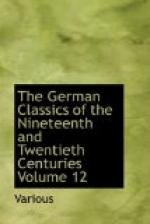But to say that Debit and Credit is a finer book than Dombey and Son is not to claim that Freytag, all in all, is a greater novelist than Dickens. The man of a single fine book would have to be superlatively great to equal one who could show such fertility in creation of characters or produce such masterpieces of description. Dickens reaches heights of passion to which Freytag could never aspire; in fact the latter’s temperament strikes one as rather a cool one. Even Spielhagen, far inferior to him in many regards, could thrill where Freytag merely interests.
Freytag’s forte lay in fidelity of depiction, in the power to ascertain and utilize essential facts. It would not be fair to say that he had little imagination, for in the parts of The Ancestors that have to do with remote times, times of which our whole knowledge is gained from a few paragraphs in old chronicles and where the scenes and incidents have to be invented, he is at his best. But one of his great merits lies in his evident familiarity with the localities mentioned in the pages as well as with the social environment of his personages. The house of T.D. Schroeter in Debit and Credit had its prototype in the house of Molinari in Breslau, and at the Molinaris Freytag was a frequent visitor. Indeed in the company of the head of the firm he even undertook just such a journey to the Polish provinces in troubled times as he makes Anton take with Schroeter. Again, the life in the newspaper office, so amusingly depicted in The Journalists, was out of the fulness of his own experience as editor of a political sheet. A hundred little natural touches thus add to the realism of the whole and make the figures, as a German critic says, “stand out like marble statues against a hedge of yew.” The reproach has been made that many of Freytag’s characters are too much alike. He has distinct types which repeat themselves both in the novels and in the plays. George Saalfeld in Valentine, for instance, is strikingly like Bolz in The Journalists or Fink in Debit and Credit. Freytag’s answer to such objections was that an author, like




